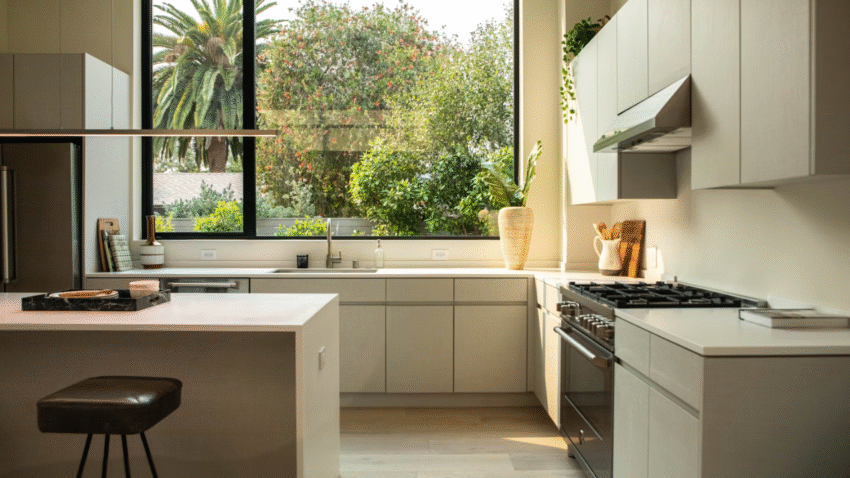Introduction
Is your kitchen sink draining slowly—or not at all? A clogged kitchen sink is one of the most frustrating and disruptive problems in any home. Whether it’s food scraps, grease buildup, or soap residue causing the blockage, this guide will show you how to unclog a kitchen sink drain quickly and effectively. With simple tools and natural ingredients, you can restore your sink’s flow without the need for a plumber.
Why Unclogging Your Sink Matters in the Kitchen
Your kitchen sink is one of the most frequently used fixtures in the home. From rinsing vegetables to washing dishes, a functioning drain is essential for keeping your kitchen workflow smooth and sanitary. A clogged drain can:
- Cause bad odors due to trapped food and stagnant water
- Interrupt meal prep and cleaning routines
- Attract pests like fruit flies or gnats
- Lead to pipe damage or flooding if ignored
By keeping your sink drain clear, you maintain a clean, efficient, and healthy kitchen environment.
Step-by-Step Guide to Unclogging a Kitchen Sink Drain
Here’s a complete step-by-step guide to get your kitchen sink draining again—fast.
1. Boil a Kettle of Water
Sometimes the simplest fix is all you need. Boiling water can dissolve minor grease or soap buildup.
- Boil a full kettle or pot of water
- Carefully pour it down the clogged drain in two to three stages
- Wait a few minutes between pours
Kitchen Tip: This method is most effective on metal pipes, not PVC, as boiling water can soften plastic piping.
2. Use Baking Soda and Vinegar
This natural, chemical-free combo is a powerful tool against clogs.
- Pour ½ cup of baking soda into the drain
- Follow with 1 cup of white vinegar
- Cover the drain with a stopper or plate
- Let it fizz and work its magic for 15–30 minutes
- Rinse with hot water
Reminder: This method works best when used regularly for maintenance, not for severe clogs.
3. Try a Plunger
If the clog remains, it’s time to bring in the plunger.
- Make sure there’s enough water in the sink to cover the plunger’s rubber cup
- Place the plunger over the drain, forming a good seal
- Pump vigorously up and down 10–15 times
- Lift quickly and check if the water starts to drain
Note: If you have a double sink, plug the other side with a wet rag to maintain suction.
4. Clean the P-Trap
When simple methods fail, the clog may be stuck in the P-trap (the curved pipe beneath the sink).
You’ll need:
- A bucket
- An adjustable wrench or channel-lock pliers
- Gloves
Steps:
- Place the bucket under the P-trap
- Unscrew the slip nuts on both sides of the trap
- Remove the trap and check for clogs
- Clean out any debris
- Reattach the trap and test for leaks
Warning: Don’t overtighten the nuts when reassembling—they can crack or strip.
5. Use a Drain Snake (Auger)
For deeper clogs, a drain snake can physically remove the blockage.
- Insert the snake into the drain or P-trap opening
- Rotate the handle clockwise while pushing forward
- Continue until you feel resistance
- Crank and pull the clog back out
- Rinse with hot water after clearing
Pro Tip: Use a mini hand-crank auger for sink drains. Avoid power tools unless you’re experienced with plumbing.
6. Try an Enzyme Cleaner (Optional)
If you’re not in a rush, enzyme-based drain cleaners are eco-friendly and effective at breaking down organic buildup.
- Pour the cleaner into the drain as directed
- Let it sit overnight for best results
- Flush with warm water the next day
Reminder: Avoid harsh chemical drain cleaners—they can damage pipes and are harmful to the environment.
Common Mistakes to Avoid
Many people unknowingly make clogs worse by using the wrong tools or techniques. Here’s what to avoid:
Mistake 1: Pouring Grease Down the Drain
Solution: Always dispose of cooking grease in a container or jar—never down the sink. Grease hardens and clogs pipes.
Mistake 2: Using Chemical Cleaners Too Often
Solution: Stick to natural or enzyme cleaners. Chemical products can corrode pipes and harm plumbing fixtures over time.
Mistake 3: Ignoring Small Clogs
Solution: Tackle slow drains early before they become full blockages. Routine maintenance prevents emergencies.
Mistake 4: Using Boiling Water on Plastic Pipes
Solution: Use hot (not boiling) water if your pipes are PVC, as extreme heat can cause warping.
Mistake 5: Forgetting to Seal the Other Drain During Plunging
Solution: If you have a double sink, block one side to create proper suction and pressure when plunging.
Extra Tips & Kitchen Hacks
Here are a few additional tips to help you prevent future clogs and keep your sink in top shape:
Tip 1: Install a Drain Strainer
A stainless steel mesh strainer catches food scraps before they enter the drain. Empty it daily.
Tip 2: Monthly Maintenance Flush
Once a month, pour a mixture of baking soda and vinegar down the drain followed by hot water to prevent buildup.
Tip 3: Use Ice Cubes and Lemon for Disposal Cleaning
If you have a garbage disposal, run a few ice cubes and lemon slices through it once a week to sharpen blades and deodorize.
Next Task: After clearing the drain, sanitize your sink with baking soda and vinegar to eliminate odors and residue.
Conclusion
Unclogging a kitchen sink drain doesn’t always require calling a plumber. With a few household ingredients, a plunger, or a drain snake, you can handle most clogs yourself. By understanding the root causes and avoiding common mistakes, you’ll keep your drain running smoothly and avoid expensive repairs. Make it a habit to clean and maintain your kitchen sink regularly—it’ll save you time, money, and stress.
Bookmark this guide to tackle clogs quickly the next time your kitchen sink backs up.
